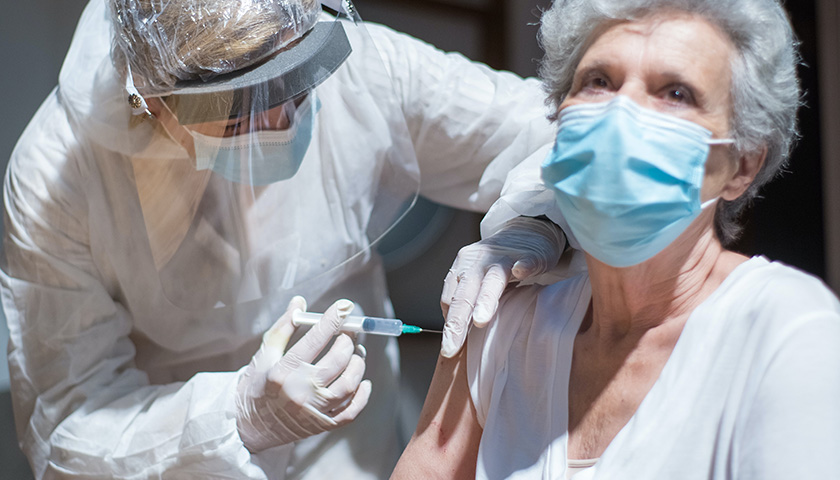by Greg Piper
Fact-checkers and Big Tech lost another round with purported COVID-19 misinformation this week, when an American Heart Association journal published research suggesting the spike protein used in mRNA vaccines can harm some people.
The peer-reviewed study in Circulation reviewed 16 adolescents and young adults hospitalized at Massachusetts General Hospital or Boston Children’s with post-vaccination myocarditis from January 2021-February 2022. All had “markedly elevated levels of full-length spike protein” in their blood, “unbounded by antibodies.”
The Harvard Medical School researchers affiliated with the hospitals did not find free-floating spike in 45 “healthy, asymptomatic, age-matched vaccinated control subjects,” despite “essentially indistinguishable” antibody profiling and T-cell responses between the two groups.
Evidence that persistent circulating unbound full-length spike protein may be causative in post-vaccination myocarditis after mRNA injections stimulate cells throughout the body to produce the same.https://t.co/hQzeo1N8KA pic.twitter.com/5qUIHo8FZm
— David Bell (@bell00david) January 4, 2023
The findings call into doubt the default response of tech platforms and media organizations when dissenting scientists question the safety of the spike protein.
LinkedIn abruptly shut down mRNA vaccine pioneer-turned-critic Robert Malone’s premium account in June 2021 when he mentioned the spike in the context of heart inflammation reports among young men. Malone later said a LinkedIn “senior executive” personally apologized for the wrongful removal.
Reuters and PolitiFact have each fact-checked Malone for claiming the spike is “cytotoxic” and harms children. “The spike proteins are harmless, do not cause illness and do not last long in the body,” PolitiFact claimed a year ago.
“Covid vaccines show your body’s natural defenses how to recognize and kill the virus, then they disappear,” former CDC Director Tom Frieden claimed in October 2021. “They don’t stay with you.”
Covid vaccines show your body's natural defenses how to recognize and kill the virus, then they disappear. They don't stay with you, they don't change your DNA, and serious adverse effects from vaccination are extraordinarily rare.
— Dr. Tom Frieden (@DrTomFrieden) October 6, 2021
Last summer, Twitter issued a strike against Kevin McKernan, who managed MIT’s research and development for the Human Genome Project, for claiming the spike protein is a “super-antigen” whose staphylococcal enterotoxin B domain has “potent toxicity.”
More than a year ago, Swedish researchers reported in the peer-reviewed journal Viruses that SARS-CoV-2’s spike protein “significantly inhibits DNA damage repair,” so it might be “safer and more efficacious” to phase out the full-length spike in COVID vaccine development.
The Circulation study has been shared by COVID vaccine skeptics, including British cardiologist Aseem Malhotra, who told Just the News last fall he first faced social media censorship after turning on mRNA products. Malhotra now calls them “one of the worst pharmaceutical interventions in the history of medicine.”
— Dr Aseem Malhotra (@DrAseemMalhotra) January 4, 2023
“Whether the circulating spike protein in the setting of mRNA vaccination was pathogenic [caused the disease] is unclear,” the researchers wrote in the full paper, calling its association with myocarditis “notable” in this cohort of 12-21 year-olds.
“There is growing in vitro evidence that spike itself can stimulate cardiac pericytes dysfunction or inflame the endothelium,” they wrote. “Thus, the spike antigen itself, which evades antibody recognition rather than invoking immune hyperactivation, may contribute to myocarditis in these individuals.”
Former Brown University epidemiologist Andrew Bostom, who threatened to sue Twitter before Elon Musk’s purchase due to two suspensions in a month for sharing COVID vaccine research, highlighted this section.
Study of C19 mRNA vax-induced myocarditis patients, aged 12-21 yos: “It is notable that spike, which remained intact (& can “inflame the endothelium”) by evading cleavage and clearance, was associated with myocarditis in this cohort.” https://t.co/IPEz22vJnV pic.twitter.com/AvEy52CdEE
— Andrew Bostom, MD, MS (@andrewbostom) January 4, 2023
The authors say the study shouldn’t be taken as evidence that COVID vaccination is generally harmful. “These results do not alter the risk-benefit ratio favoring vaccination against COVID-19 to prevent severe clinical outcomes,” according to a box on “clinical implications.”
The paper neglects to mention COVID’s estimated infection fatality rate for young people, however.
Stanford Med epidemiologist John Ioannidis, whose early-pandemic study of COVID infection rates put a target on his back, and his Meta-Research Innovation Center team published their latest update on IFRs Sunday in the Elsevier journal Environmental Research.
Based on 31 “systematically identified national seroprevalence studies in the pre-vaccination era,” the median IFR for ages 0-19 was 0.0003% and for 20-29, 0.002%. That means 3 and 20 fatalities in a million, respectively.
“The current analysis suggests a much lower pre-vaccination IFR in non-elderly populations than previously suggested,” the study says. The team’s year-ago update cut IFR in half for young people.
Stanford Prof Ioannidis et al Covid pre-vaccination Infection Fatality Rate paper is now peer-reviewed & published. Conclusions all same.
Catastrophic societal harms imposed d/t irrational fear & mass hysteria of a virus with IFR lower than influenza. https://t.co/C41V8d0DGr
— Kulvinder Kaur MD (@dockaurG) December 30, 2022
The Circulation paper, accepted for publication the day before Thanksgiving, came out a day after Harvard Med promoted the FDA’s call for Americans regardless of risk level to get so-called bivalent boosters after completing their primary series or monovalent booster. That would mean a minimum three spike exposures for children as young as six months.
The medical school cited modeling by the Commonwealth Fund that claims an extra 75,000 lives could be saved over three months if Omicron-Wuhan strain boosting reached the same rate as flu vaccination for the 2021-2022 season. That model was updated after the FDA’s mouse data-based authorization of bivalents but before research questioning their claimed superiority.
Mass General Brigham, which is Harvard Med’s teaching hospital, downplayed the importance of the Circulation paper’s findings in its press release on the study. It put the first mention of the spike protein below identical consecutive sentences reading: “Risk of severe COVID-19 continues to outweigh rare risk of post-vaccination myocarditis.”
The release’s first paragraph also emphasizes the purported rarity of the adverse event, citing an uncredited statistic without age breakdowns.
CDC and FDA did not take vaccine induced myocarditis seriously in part because safety signal was hid by not focusing on young men
Full video on YouTubehttps://t.co/gc3S8JzsL3 pic.twitter.com/6QYnc28lxP
— Vinay Prasad MD MPH (@VPrasadMDMPH) January 4, 2023
“If the risk of myocarditis is not stratified by pertinent risk factors, it may be diluted for high-risk and inflated for low-risk groups,” according to a new peer-reviewed paper by University of California San Francisco epidemiologist Vinay Prasad in the European Journal of Clinical Investigation, owned by academic publisher Wiley & Sons.
Prasad reviewed how many risk stratifiers — sex, age, dose number and manufacturer — were used in 29 post-vaccination myocarditis and pericarditis studies. A plurality (45%) had one or fewer, while 28% had all four.
“The highest incidence of myocarditis ranged from 8.1-39 cases per 100,000 persons (or doses) in studies using four stratifiers,” the paper says. Six studies found at least 15 cases per 100,000 persons or doses for 12-24 year-old males after the second mRNA dose.
“Dose 2 is worse than dose 1. Moderna is worse than Pfizer,” Prasad wrote in an accompanying essay for the Sensible Medicine newsletter Tuesday. “But these differences are lost in analyses that lump together products or combine young men and old women.”
– – –
Greg Piper has covered law and policy for 15 years, with a focus on tech companies, civil liberties and higher education.
Photo “Vaccine” by Kampus Production.






